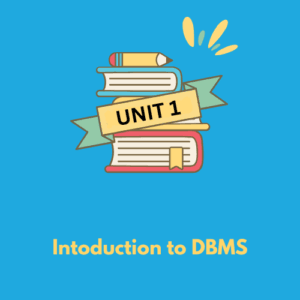
Click On the Download Button Below 
Introduction to DBMS :-
A database is a collection of information that is organized so that it can be easily accessed, managed and updated. Database systems are designed to manage large bodies of information. Management of data involves both defining structures for storage of information and providing mechanisms for the manipulation of information. In addition, the database system must ensure the safety of the information stored, despite system crashes or attempts at unauthorized access. If data are to be shared among several users, the system must avoid possible anomalous results. Because information is so important in most organizations, computer scientists have developed a large body of concepts and techniques for managing data.
DATABASE MANAGEMENT SYSTEM
A database-management system (DBMS) is a collection of interrelated data and a set of programs to access those data. This is a collection of related data with an implicit meaning and hence is a database.
Objectives of DBMS :-
After going through this unit, you will able to:
- To introduce the concept of the DBMS with respect to the relational model.
- Define database, DBMS, overview of DBMS, level of abstraction, DBMS architecture.
- Learning Data models and its different
- Designing the database schema with the use of appropriate data types for storage of data in database.
- To create, manipulate, query and back up the
Summary of Introduction to DBMS :-
A Database Management System (DBMS) is software that manages and organizes data in a structured way, allowing users to store, retrieve, and manipulate data efficiently. It provides a systematic approach to managing databases, ensuring data consistency, integrity, and security.
Key concepts:
- Database: A collection of related data that is organized in a way that allows easy access and management.
- DBMS Definition: A DBMS is software that facilitates the creation, management, and manipulation of databases.
- Overview of DBMS: A DBMS helps in managing large amounts of data by providing a systematic way of storing, retrieving, and updating data.
- Advantages of DBMS:
- Data redundancy reduction
- Improved data security
- Data integrity and consistency
- Support for concurrent data access
- Efficient data retrieval and management
- Levels of Abstraction: A DBMS provides different levels of abstraction, allowing users to interact with the data at different levels (e.g., physical, logical, and view levels).
- Data Independence: DBMS provides data independence, meaning that changes in the data structure do not affect the application programs.
- DBMS Architecture: DBMS typically follows a layered architecture, with components like the database engine, query processor, and user interfaces. The architecture ensures efficient data management and interaction.
In summary, a DBMS is crucial for organizing and managing data, ensuring consistency, security, and accessibility in various applications.
Database Systems Subject Link
